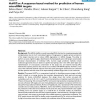Free Online Productivity Tools
i2Speak
i2Symbol
i2OCR
iTex2Img
iWeb2Print
iWeb2Shot
i2Type
iPdf2Split
iPdf2Merge
i2Bopomofo
i2Arabic
i2Style
i2Image
i2PDF
iLatex2Rtf
Sci2ools
ALMOB
2008
2008
HuMiTar: A sequence-based method for prediction of human microRNA targets
Background: MicroRNAs (miRs) are small noncoding RNAs that bind to complementary/partially complementary sites in the 3' untranslated regions of target genes to regulate protein production of the target transcript and to induce mRNA degradation or mRNA cleavage. The ability to perform accurate, high-throughput identification of physiologically active miR targets would enable functional characterization of individual miRs. Current target prediction methods include traditional approaches that are based on specific base-pairing rules in the miR's seed region and implementation of cross-species conservation of the target site, and machine learning (ML) methods that explore patterns that contrast true and false miR-mRNA duplexes. However, in the case of the traditional methods research shows that some seed region matches that are conserved are false positives and that some of the experimentally validated target sites are not conserved. Results: We present HuMiTar, a computational...
ALMOB 2008 | MiR Targets | Seed Region | Target Sites |
| Added | 08 Dec 2010 |
| Updated | 08 Dec 2010 |
| Type | Journal |
| Year | 2008 |
| Where | ALMOB |
| Authors | Jishou Ruan, Hanzhe Chen, Lukasz A. Kurgan, Ke Chen 0003, Chunsheng Kang, Peiyu Pu |
Comments (0)

